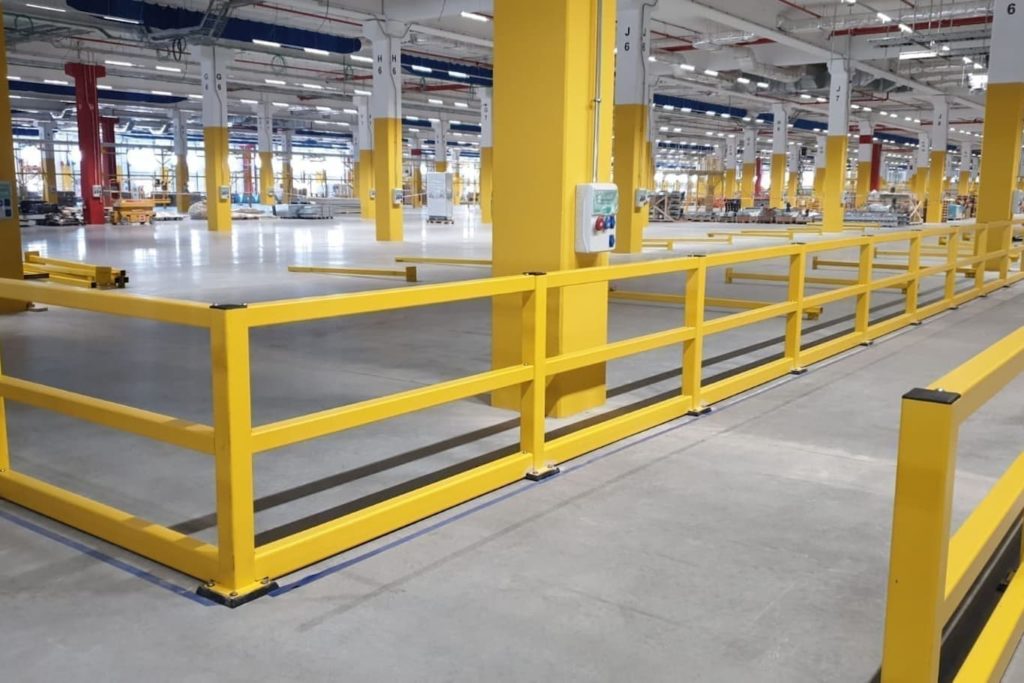Terminology, ratings and product categories can make choosing the right pedestrian barriers for your workplace challenging. This guide directs you along the right path.
The best safety barriers & guardrails are ones manufactured to meet the highest traffic safety standards. That is the only way to avoid workplace injuries to staff or visitors, and stay compliant with H&S legislation. However, choosing the right pedestrian barriers can be tricky as there are different types.
For example, do you need a heavy-duty option with a reliable degree of impact absorbance? Which are the best high-vis foot traffic guides, especially on the edges of off-road vehicle routes?
As there are now pedestrian barriers designed and manufactured to fit various locations and levels of activity in workplaces, you need to find the most appropriate one to manage each risk.
For example, some barriers are specifically designed for areas where HGVs and HLGVs operate, and others slot perfectly into warehouse interiors to segregate your workforce and forklift trucks.
Do you know which products provide a handrail as pedestrians transition between ground level and mezzanine floors, or up steps? Also, there are specific pedestrian barriers to stop people from getting too close to sensitive or dangerous equipment in your workplace, or to ensure they don’t bump into racking systems.
To add to your understanding of this important traffic management issue, we have gathered information on the best pedestrian barriers.
Pedestrian Handrail Systems
Safety barriers & guardrails don’t just direct foot traffic along a set route by providing pedestrians with a visual indicator of danger. They also offer pedestrians a firm barrier to hold on to in areas that present a trip, slip or fall risk.
The best pedestrian handrails are suitable to use internally or externally and come in an easy to assemble modular form. That way, they can be used for diverse locations and risks.
For instance, to manage safety in:
• Car park walkways
• Exits and entrances
• Uneven pathways and internal floors
• Multi-level flooring
• Manufacturing and engineering spaces (guiding pedestrians away from machinery)
• Work areas close to electrical equipment or other incursion hazards.
Pedestrian Safety Barriers (SEG+)
Pedestrian safety barriers (SEG+) have been designed and manufactured to give an advanced level of protection in areas where industrial vehicles operate. They come in yellow/black to identify hazardous situations, and accessories include Pedestrian Sprung Return Gates and Demountable Shoe Plates. This makes it easy to create a practical flow of pedestrians around your site, without letting them stray into the path of moving machinery, for example.
How else could you use this type of pedestrian barrier?
• Preventing encroachment on LV and IT Cabinets.
• Managing the risks from walking on and off mezzanine floors.
Guardrail Systems (MHE/PIT)
Safety barriers for your warehouse need to be fit for purpose, durable and reliable.
Places where off-road vehicle traffic is most intensive and risky for pedestrians demand specially designed barriers. Particularly guard rails able to withstand impact from Material Handling Equipment (MHE) and Powered Industrial Trucks (PIT).
A heavy-duty steel guard rail system can avoid serious workplace accidents, and of course fatalities. Though it is recommended that you find versions with foam gaskets as standard (underneath the base rail) to prevent dirt and debris gathering, Also, closed-cell construction resists corrosion from guardrail cleaning processes.
Apart from segregating people and off-road vehicles and machinery, what other purpose do they serve?
• By opting for destacker extensions for your steel guard rails, you can increase the height to around 3000mm, for shielding high-level racking or pallet stacks.
• The same height increase can make these products ideal to guard heavy-duty machinery.
Armco Barrier Systems
Armco safety barriers are the gold standard for traffic management on public as well as private roads. Their distinctive and ingenious design creates an impressive degree of impact absorbency.
When using them to help keep drivers and pedestrians safe on your worksite, Armco Pedestrian Safety Ends come highly recommended.
These safety ends provide an essential layer of protection if pedestrians inadvertently come into contact with your Armco barriers. The yellow or black safety ends prevent damage to limbs, torsos or clothing.
More insights on choosing the right pedestrian barriers
With all the different options available, it can be difficult knowing which pedestrian barrier is suitable for your site. This guide has outlined several popular pedestrian barriers, their features, and applications.
With this in mind, we hope this blog has helped you understand how to choose the right pedestrian barriers to properly protect pedestrians on and around your premises.









